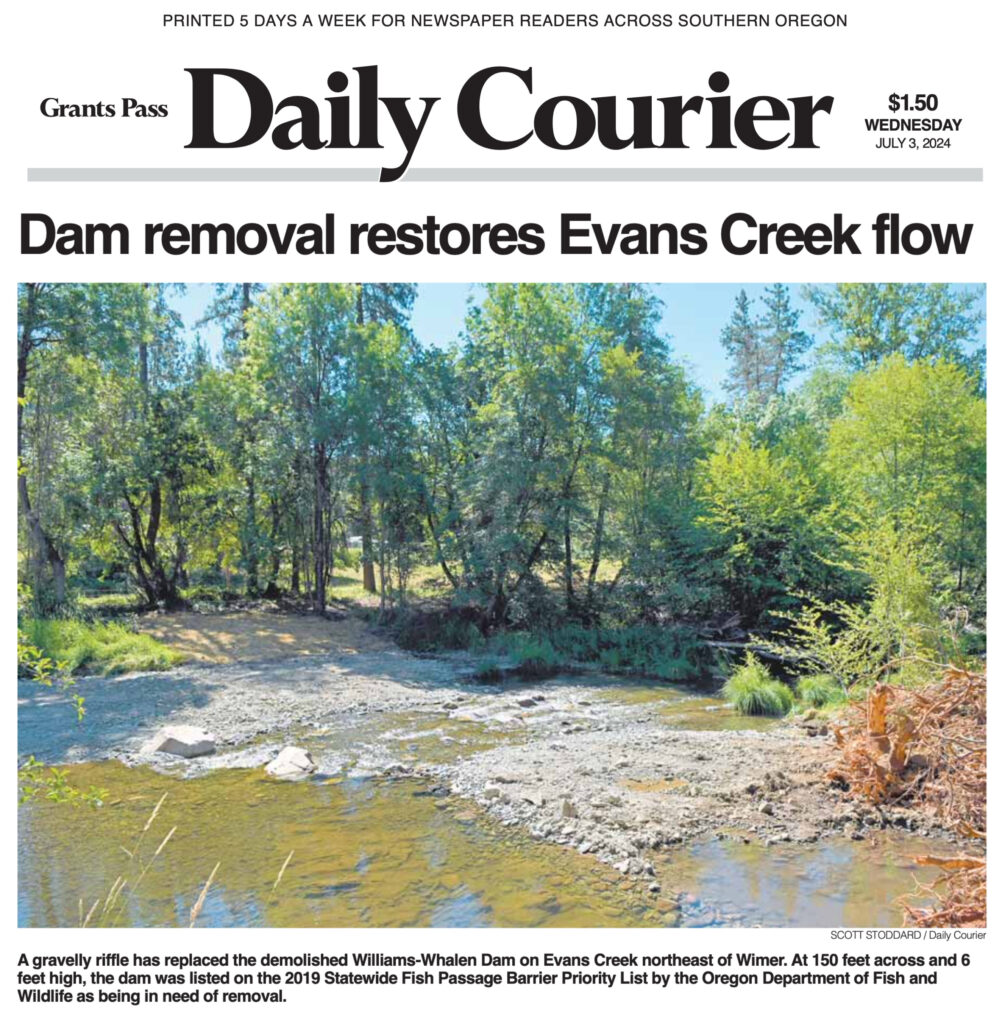By Susan Hiland | July 3, 2024 | Grants Pass Daily Courier
A work crew last week moved logs into place along the edge of Evans Creek, creating new habitat for small critters to hide and eat in.
Just days before, the spot was the site of the old Williams-Whalen Dam, which stood for 128 years before it was demolished to once again allow for the natural movement of salmon, steelhead, and other fish.
Recreating habitat was the last finishing touch of a two-year project that made Williams-Whalen the third fish-impeding dam to be removed from the creek in the Evans Valley area of eastern Jackson County.
“This was not an insignificant dam,” said John Speece, project manager for the Rogue River Watershed Council.
Said Melanie Klym, a senior engineer from River Design Group who helped on the project, “This went from being a hot bathtub to a flowing stream.”
At 150 feet across and six feet high, the dam was listed on the 2019 Statewide Fish Passage Barrier Priority List by the Oregon Department of Fish and Wildlife as being in need of removal.
Demolition of the dam was part of a larger collaborative effort to restore access to habitat for native salmon and steelhead in Evans Creek, a key spawning tributary of the Rogue River.
“It had been over 50 years ago that the dam was used with water rights,” Speece said. “It served no legal purpose today. Once it went down, the fish can flow more freely.”
The $500,000 project was part of an ongoing effort in the Rogue Basin that has identified dozens of dams and some 3,000 culverts and other barriers that inhibit fish movement.
Since 2004, more than two dozen barriers have been removed and a dozen more improved for fish passage.
Some, like Savage Rapids Dam in 2009, Gold Ray Dam in 2010, and Fielder Dam on Evans Creek in 2015, were huge, multi-million-dollar demolition projects.
Others, like Harbolt Dam in 2021 and Lovelace Dam in 2023, both on Slate Creek in the Wilderville area southwest of Grants Pass, were smaller affairs. Pomeroy Dam in Cave Junction, listed for years as the number one obstruction on the priority list for the Rogue Basin, is next.
Part of the problem with the Williams-Whalen Dam was it did not have a fish ladder, which would have helped more fish get past the dam and further up the creek.
“The older larger fish could get over the dam but the little ones would flip over and not be able to manage it,” Speece said. “They died.”
Biologists say the removal of the Williams-Whalen Dam is going to improve 37 miles of spawning and rearing habitat for salmon and steelhead while also replacing invasive streamside blackberry on the cooperating landowners’ properties with native vegetation and riparian fencing.
“We got the cooperation from the two landowners where the dam was located on their property,” said Speece.
“We are placing log structures along the creek edge to facilitate a new habitat for the smaller fish to live, hunt and hide,” he said. “Using wood in creeks is a good thing because it creates structure for the habitat.”
They also placed more wood along the edge to keep the river from flowing back down the old channel.
Before work started on the dismantling, the U.S. Fish and Wildlife Service led fish salvage operations at the site, assisted by staff from Oregon Department of Fish and Wildlife and the Bureau of Land Management as well as local volunteers.
“This is great news for salmon and steelhead, and the many people who love the Rogue River,” said Jim McCarthy, Southern Oregon program director for WaterWatch of Oregon, the fish enhancement group that has been instrumental in the removal of dams.
“For the owners of the land, it will be a release of liability for them,” McCarthy said. “The owners did not use it.”
State and federal agencies identified Evans Creek as a place that could help improve access to quality fish habitat in its upper reaches by taking out the dams.
It is as important to the recovery of Southern Oregon/Northern California Coast coho salmon, listed as threatened under the Endangered Species Act, according to McCarthy.
Many types of fish use the creek, including coho and chinook salmon, summer and winter steelhead, cutthroat trout, Klamath small-scale suckers, and Pacific lamprey.
WaterWatch previously secured dam removal agreements from the two private landowners, which ensured removal at no cost to them, McCarthy said.
The nonprofit group partnered with the U.S. Fish and Wildlife Service, the Oregon Department of Fish and Wildlife and Rogue Basin Partnership to secure funding for the project.
The state provided $472,000 in grant funding, the feds provided $25,000, Rogue Basin Partnership provided $6,144, and PacifiCorp provided $4,000, according to WaterWatch.
This article originally appeared in the July 3rd, 2024, issue of the Grants Pass Daily Courier. We thank the Daily Courier for generously supplying WaterWatch with a hard copy of the July 3rd issue. A PDF of the article can be found here.
Banner photo by the Daily Courier’s Scott Stoddard.

